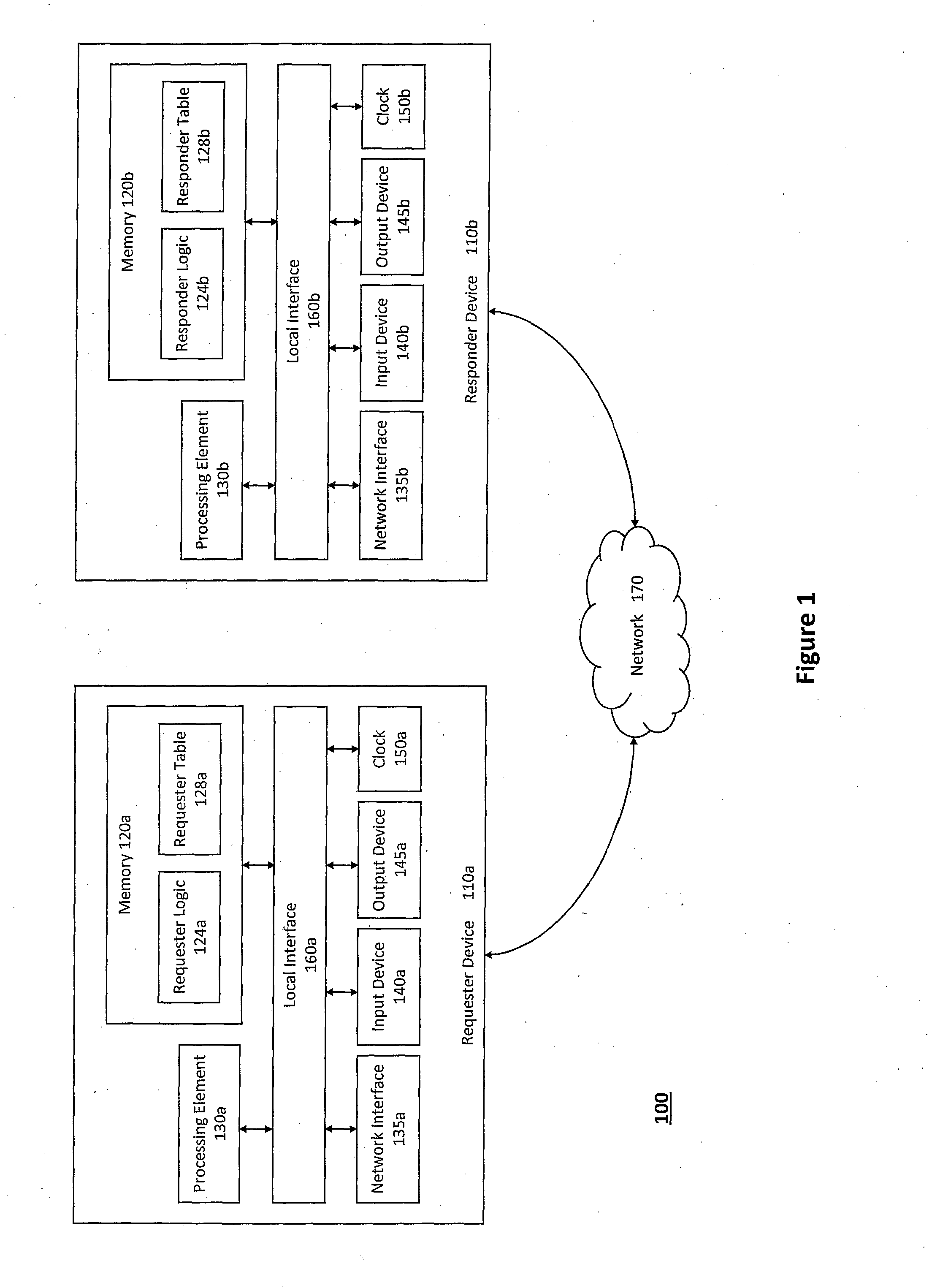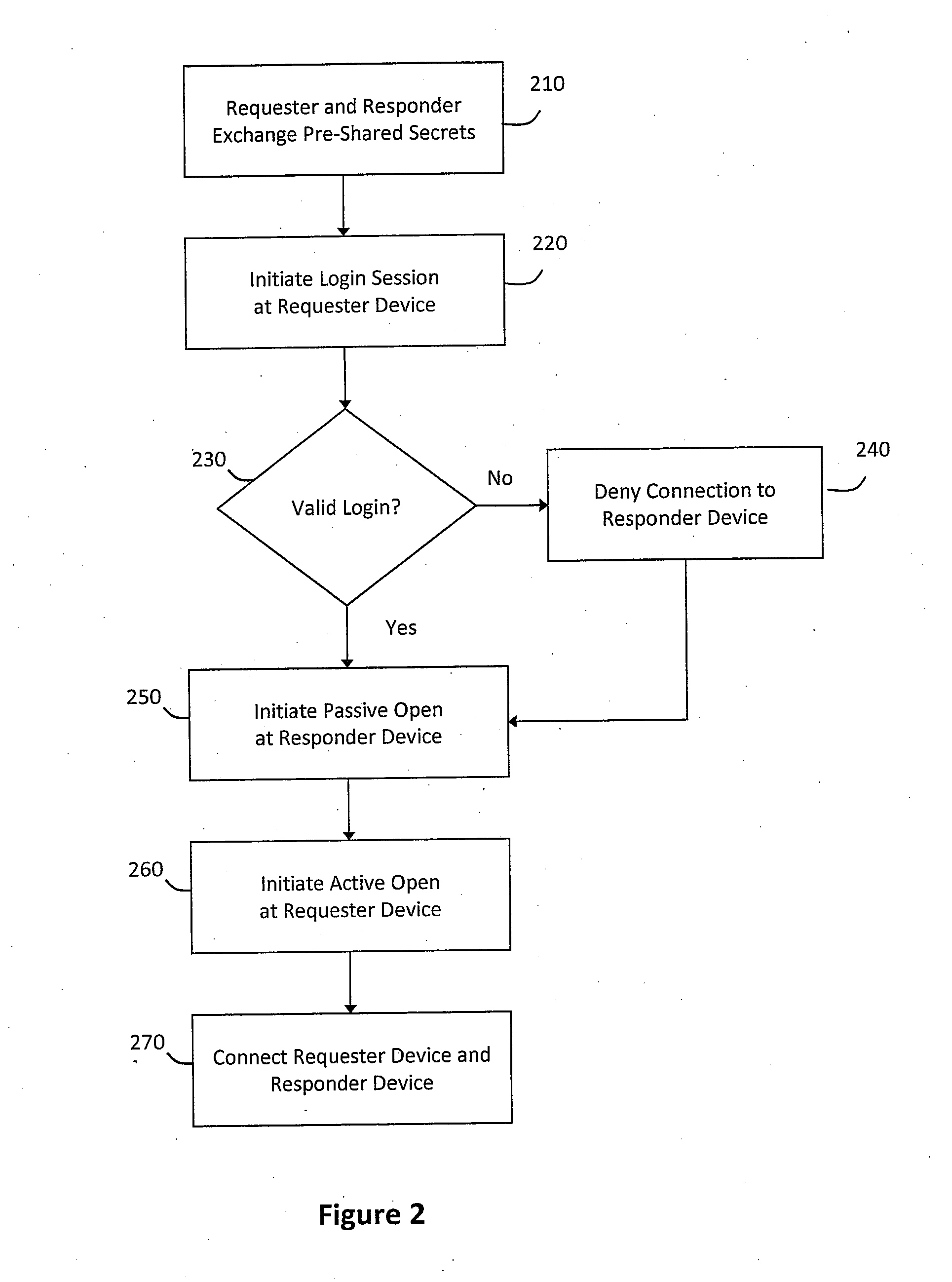[0020]According to one aspect of the invention, the unified transport and security protocols may generally extend features provided by the
User Datagram Protocol (UDP), which typically involves network devices communicating short messages (sometimes referred to as “datagrams”) to one another. Network devices often use UDP for communications that relate to real time applications (e.g., video and audio) because UDP provides various features that can avoid connection setup processes, flow control, and
retransmission, thereby minimizing transmission delays. However, UDP generally does not provide the reliability and ordering guarantees provided by protocols such as the
Transmission Control Protocol (TCP), as datagrams may be dropped without notice or arrive out of order. Nonetheless, without the overhead required to check whether every packet actually arrived, UDP can be faster and more efficient for many lightweight or
time sensitive purposes. Furthermore, the stateless nature of UDP makes the protocol useful to servers arranged to respond to a large number of small queries received from a large number of
client devices. Thus, the unified transport and security protocols that will be described in further detail herein may include a Secure Frame Layer (SFL) transport and security protocol that can be used to manage data transfer and
authentication for packets communicated between network devices, and may further include a privacy protected UDP extension referred to as Secure Persistent UDP (SPUDP), which may address UDP
packet loss, maintain communication sessions, and defend against denial of service attacks.
[0021]For example, according to one aspect of the invention, the Secure Frame Layer transport and security protocol may be used to prevent denial of service attacks at a requester device and a responder device (e.g., the responder device may authenticate packets received from the requester device via the Secure Frame Layer transport and security protocol, and the requester device may authenticate packets received from the responder device in a similar manner). In particular, to defend both the requester device and the responder device from denial of service attacks, the Secure Frame Layer transport and security protocol may include a stage for initially configuring the requester device and the responder device, a stage for identifying the requester device and the responder device to one another, and a stage for authenticating message frames communicated between the requester device and the responder device. The responder device can therefore determine whether the requester device has permission to access one or more systems protected by the responder device prior to the responder device granting such access or performing any further computations or storing a state for the message frames, thereby preventing denial of service attacks at the responder device and the systems that the responder device protects (and vice versa).
[0023]According to one aspect of the invention, the unified transport and protocols described herein may be used to generate the access filter values from a keyed Hash
Message Authentication Code (HMAC), which is less vulnerable to denial of service or distributed denial of service attacks than schemes that are based on signatures or
Public Key Infrastructure (PKI) certificates. Because HMAC and other keyed hash functions have less computational overhead than PKI-based or signature-based schemes, the unified transport and security protocols may be suitably implemented on a firewall, an access point, a
server, or any other network device that can act as a responder device in accordance with the techniques described herein. Furthermore, the HMAC function may be combined with an
Advanced Encryption Standard (AES) with
Cipher Block Chaining (CBC) to guarantee data
confidentiality and integrity during communication sessions that employ the transport and security protocols to authenticate message frames. In addition, the HMAC function employed herein may generate message
authentication codes with the
Secure Hash Algorithm-1 (SHA-1), which is cryptographically stronger and provides superior security in
Internet Protocol Security (
IPSec) than functions that are based on Message-Digest
algorithm 5 (MD5).
[0024]According to one aspect of the invention, the Secure Frame Layer transport and security protocol may include an Initial Configuration Stage (ICS) that initially configures a requester device and a responder device, a Session
Mutual Authentication Stage (SMAS) that identifies the requester device and the responder device to one another, and a
Dynamic Data Communication Stage (DDCS) that authenticates subsequent message frames that the requester device may communicate to the responder device. Furthermore, the Secure Persistent UDP transport and security protocol may include a receive mode in which the responder device may authenticate message frames from the requester device and update the access filter value for the requester device as appropriate, a
recovery mode in which the requester device can be reset in response to losing one or more message frames sent to the responder device, a
retransmission mode in which the requester device can attempt to resend the lost message frames to the responder device in order to avoid
packet loss, and an update mode in which the requester device updates location information to restore
connectivity in a communications session with the responder device. The transport and security protocols may also be designed in accordance with stateless principles in order to prevent denial of service or distributed denial of service attacks.
 Login to View More
Login to View More  Login to View More
Login to View More 


